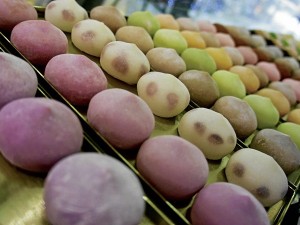
Mochi cream is my favorite indulgence for the New Year. These round, sticky, tasty, authentic Japanese treats are made with utmost care and only with high-quality ingredients. For starters, the mochi skins alone are so fine and delicate, though still chewy, and melts in your mouth. The fillings are made of the real ingredient with no artificial flavorings, and the center consists of white-as-snow, delectably pure, thick cream.
Mochi Cream has over 100 flavors in Japan, and 24 of them are now in Manila: Apple Pie, Orange Cheese, Sakura, Raspberry Pralines, Blueberry Yoghurt, Chocolate Banana, Cafe au Lait, Green Tea, Red Sweet Potato, Black Sesame, Chocolate, Caramel Pudding, Green Soybean, White Chocolate, Caramel Machiato, Houji Tea, Sweet Potato, Darjeeling, Honey Cranberry, Mango, Red Bean, Peach Yoghurt, Rum Raisin, and Black Soybean Flour.
The flavor combinations are so interesting, making the pickings suitable for just about any palate. In fact, you’ll never get tired eating them, as they all taste very different from each other. My personal favorites are the Green Tea, Green Soybean, Red Sweet Potato, Sakura, Houji Tea, Black Soybean Flour, Black Sesame… I practically love them all.
The caramel pudding is mochi stuffed with flan, with caramel oozing out of it. Sarap! The orange cheese is interesting—hints of orange with tangy cheese.
For best results, thaw the mochi 15 minutes before serving. They are best eaten between half-frozen and chilled. So addicting!
Mochi Cream comes from the same factory that supplies upscale stores such as Mitsukoshi and Matsuzakaya, and are now locally available at the 5/F, SM Podium; and 2/F, SM The Block (in front of Uniqlo and Forever 21). Call tel. 0917-8150888 or 0917-8932199 for queries or bulk orders.
Atching Lillian’s diary of Christmas dishes, continued
“We always had fruit salad made from fruits we grow in our garden; picked when in season, my mother and grandmother preserved them in syrup. For noche buena, they drained the fruits and added homemade mayonnaise and sugar in the absence of cream.
“Our Christmas table always had ham, yellow delicious apples, grapes, castañas and ensaimada. Back then, ensaimada was served only during very special occasions. There were no bakeshops, so each household had its own secret recipe.”
Ensaimada secrets and recipe:
Sixty to 70 egg yolks per recipe. The nicest to use were duck eggs.
Another secret is pork fat, extracted from the belly. It was washed, sliced into small strips, and cooked on a thick metal pan over low heat to extract the oil. In some recipes you’ll find oil; before, that oil was pork lard. My grandmother used to roll the dough out, brush it with lard on the center then grate queso de bola over. She then rolled and started coiling the dough to shape it. Ensaimada made with pork lard was very tasty, but not as light and fluffy.
Old-fashioned Ensaimada
Dough:
2 tbsp yeast
1 c lukewarm water
1 tbsp sugar
2 c all-purpose flour
Mix all ingredients to make a sponge dough.
Let stand for 30 minutes then add:
2½ c butter
2½ c sugar
½ c oil
60 egg yolks
2½ c milk
1 tsp salt
3 kg all-purpose flour
Procedure:
Mix and knead to a smooth paste.
Let stand until it rises to double its size (1½-2 hours).
Punch the dough down.
Divide into 24-28 portions, 200 g each for big ensaimada.
Let rest again for 10 minutes.
Roll dough out and brush with butter or lard and grated queso de bola, then coil.
Put on buttered molds.
Let rest for 1 hour, or until double in size.
Bake in a preheated (300 °F) oven for 25 minutes, or until light brown.
Remove from mold; cool.
Brush with butter and sprinkle with sugar and top generously with queso de bola.
More from Atching Lillian: “There was usually so much food during noche buena that the ensaimada were mostly consumed for breakfast on Christmas morning with chocolaté.
“Our chocolate was made with 70-percent cacao and 30-percent peanuts. We first picked cacao of the same size and soaked them in water. In a thick talyasi (clay wok), we toasted the cacao and left it to cool. Once cool, it was peeled. We did the same thing with the peanuts. Nuts must be the small native ones, shelled but toasted, skin on. After that, we pounded the cacao and the peanuts, then ground them. The mixture was stored in bottles. Come Christmas morning, we mixed 1 tbsp chocolate (in a little water first) then we mixed in 1 1/3 c of carabao’s milk (you may add more). We sweetened it with sugar (when condensed milk became available, we added condensed milk). We cooked the mixture in a copper chocolatera. Ima cooked it over low heat, to a low, slow boil. Once on gentle boil, she would recite one Hail Mary, and with a batirol start to beat the chocolate until it was bubbly. She poured the chocolate on demitasse cups and served it with her giant ensaimada…
“This is how I recall the Christmases of my youth to be.”
To order old-fashioned treats made just as they were in the olden days, visit Atching Lillian Borromeo’s Facebook page.









































